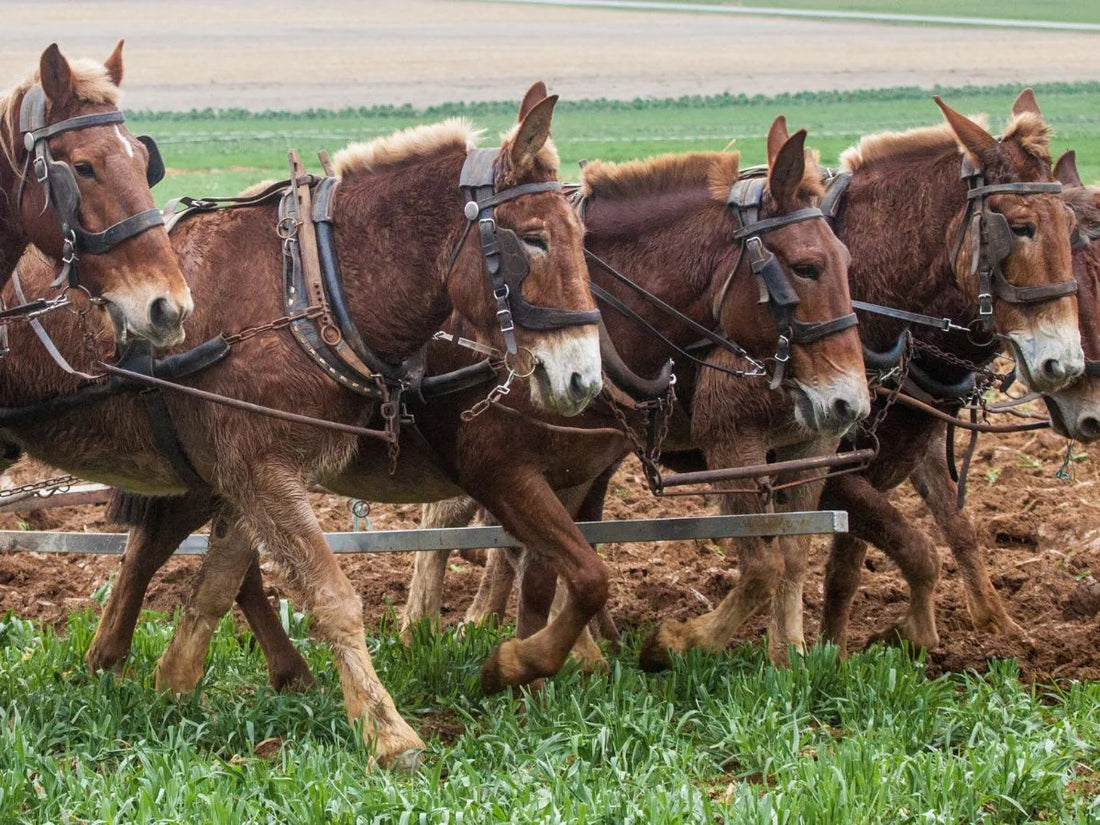
In 1925, mules were the most widely used draft animal in use on Southern farms, surpassing the horse as a plow animal. Farmers highly valued these hard-working creatures, which are a cross between a horse and a donkey. Mules can be of either sex, but all of them are sterile and cannot breed with one another. At the peak of “muledom” there were nearly six million mules in the United States, with nearly all of them in the South.
The mule is the offspring of a mare, which is a female horse, and a jack, a male ass. If a jenny, a female ass, is bred with a stallion, a male horse, the resulting animal is known as a hinny. Discerning between a hinny and a mule requires expert knowledge, as the primary distinction lies in the slightly narrower heels of the hinny. Mules are preferred, as the mule tends to be less stubborn and more cooperative.
Mules inherit characteristics from each of their parents, both horse and donkey. They adopt their braying voice, sure-footedness, endurance, long ears, thin limbs, and small feet from the donkey. From the mare, they get their large bodies, powerful muscles, and height. The mule’s size depends on the size of the mare.
Mules from Belgian and Percheron mares, or any large draft mares, are considered superior due to their larger size, along with their big bones, heads, ears, and peaceful dispositions. A 1200- to 1300-pound draft mare will produce mule offspring that weigh around 900 pounds. Mules born of saddle mares will naturally be smaller, typically about 15 hands (60 inches) or less, and have slender bones, small feet, and more excitable temperaments, because a good saddle mare tends to be more spirited and high-strung compared to a workhorse.
In 1860, at the beginning of the Civil War, only about a third of the South’s draft animals were mules, with horses being favored. But a combination of the South’s geography, plus the hardiness of the mule, would soon see this number change substantially. Eventually, mules would make up more than three-quarters of all draft animals in the South. Today, we think of technological innovation as meaning things like the capacity of computer chips to hold more information or even events such as the rise of artificial intelligence. But the ascendency of the mule over the horse in Southern agriculture was itself an important technological advance.
Summers in the South can be quite unforgiving, and mules tolerate hot, humid conditions much better than horses, as they have thicker skin. They also eat less and live ten to fifteen years longer than a horse, living up to fifty years. They have smaller feet than horses and are more surefooted on rough terrain and unlike horses, they pull straight ahead. Mules won’t “work themselves to death” in the heat like a horse, but as they get warmer, will slow down to converse energy. For example, a pulling horse can out pull a mule. This is because a horse will use every bit of strength he has. A mule, if he finds a load too heavy, simply won’t pull it.
Mules are very intelligent and are quite trainable. Normally quite docile, they can pack a kick, not only from the rear but from the side as well. Mules have a reputation for being stubborn, per the old saying, “He’s as stubborn as a mule.” This comes from the mule’s natural resistance to being overworked and they have a strong instinct for self-preservation.
Like many animals, mules get attached to the person who works with them. They will get used to their new situation if given time, but seem to suffer from homesickness if sold to a new owner. After farms became mechanized and mules were not needed for plowing or pulling a hay wagon, it seemed for a while they might die out. But mules seem to be making a resurgence in the United States, especially among hobby farmers who value their easygoing natures. Today there are about ten million mules left on the planet, with most of them in Mexico, China, Brazil, Morocco, and Ethiopia.
Mules were valuable draft animals in the rural South, especially during the years of the Great Depression. They were considered by farmers as one of their prized possessions and were interwoven into everyday life in the South, so much so that automobiles were initially resisted.
Here are a few of our favorite quotes about mules:
“My favorite animal is the mule. He has more horse sense than a horse. He knows when to stop eating – and he knows when to stop working.” ~ Harry S. Truman
“A mule will labor ten years willingly and patiently for you, for the privilege of kicking you once.” ~ William Faulkner
“There is nothing to be learned from the second kick of a mule.” ~ Mark Twain
